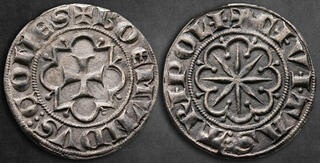Lot description:
Crusaders. Tripoli (County). Bohemond VI AD 1251-1275.
Groš AR
25 mm, 3,02 g
✠ BOEMVNDVS⁝COMES, cross within frame of alternate arcs and angles / ✠ CIVITAS⁝TRIPOLI, eight-pointed star within eight arcs.
Attractively toned, Good Very Fine
CCS 22; Metcalf, Crusades, 490; Wäckerlin 61.
Bohemond IV of Antioch, also known as Bohemond the One-Eyed, was a prominent figure in the complex and tumultuous era of the Crusader states in the Levant during the 12th and 13th centuries. His reign was marked by continuous conflicts, both with the Muslim states surrounding his territories and with his Christian rivals within the Crusader states themselves. Amidst this backdrop of incessant warfare and political intrigue, the coinage minted during his rule served not only as a medium of economic transaction but also as a tool for political propaganda and a symbol of his sovereignty over the County of Tripoli.
The gros, a silver coin from the reign of Bohemond VI, not IV, as mentioned, provides a fascinating glimpse into the numismatic practices of the period and the iconographic elements used by Crusader states to assert their Christian identity and authority in a predominantly Muslim region. The coin, weighing 4.41 grams with a diameter of 25 mm, is a testament to the sophisticated metallurgical and artistic capabilities of the time.
The obverse of the coin proudly bears the inscription "✠ BOEMVNDVS⁝COMES," identifying Bohemond VI as the Count (Comes) and situating the coin squarely within the feudal and chivalric order that underpinned Crusader society. The central motif, a cross within a frame of alternate arcs and angles, is emblematic of the Crusaders' fervent Christian faith and their claim to the Holy Land, both as warriors of Christendom and as rulers by divine providence.
The reverse features the inscription "✠ CIVITAS⁝TRIPOLI," signifying the coin's issuance from the city of Tripoli, the capital of the county and a crucial commercial and military hub in the Crusader East. The eight-pointed star within eight arcs is a motif rich in symbolism, potentially reflecting the Crusaders' adaptation and integration of local artistic traditions into their own cultural expressions. This blend of Western and Eastern elements on the coin mirrors the broader cultural syncretism that characterized the Crusader states.
Catalogued by numismatists with references such as CCS 22, Metcalf's "Crusades" 490, and Wäckerlin 61, the gros of Bohemond VI is noted for its well-struck condition and beautifully toned appearance, classified as "About extremely fine." Such coins are valuable not only for their aesthetic and material worth but also for their historical significance, offering insights into the economic, political, and cultural dimensions of the Crusader states.
The coinage of Bohemond VI, including the gros described above, thus serves as a tangible connection to a past where faith, war, and diplomacy were interwoven into the fabric of daily life in the Crusader states. These coins are more than just artifacts; they are relics of a bygone era that continue to fascinate historians, numismatists, and collectors alike, providing a window into the complexities and contradictions of Crusader rule in the Levant
Starting price: 150 EUR |  |